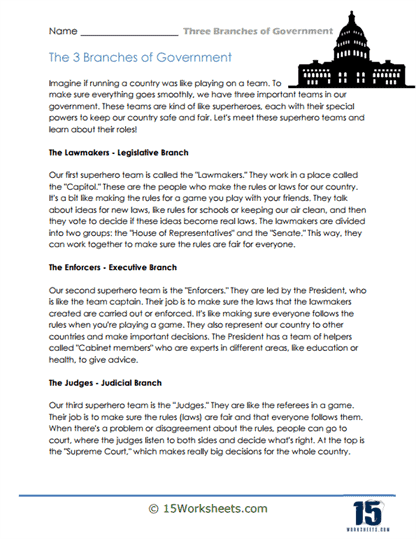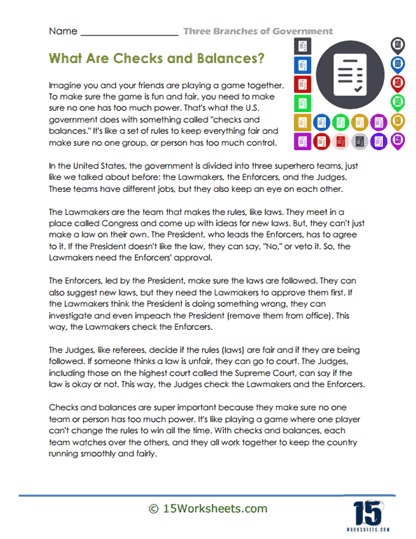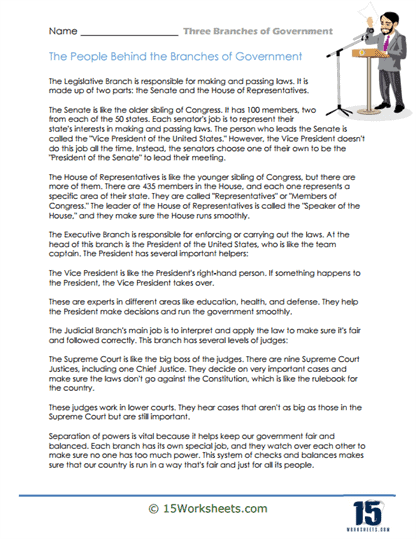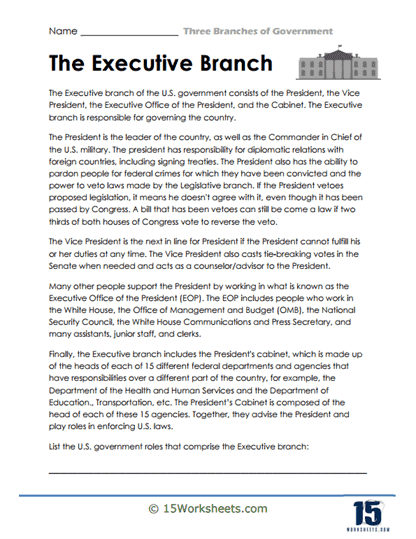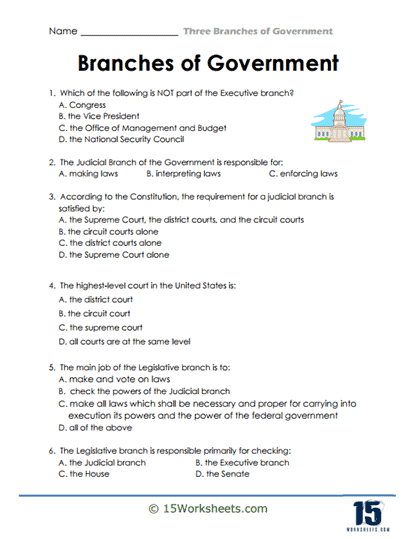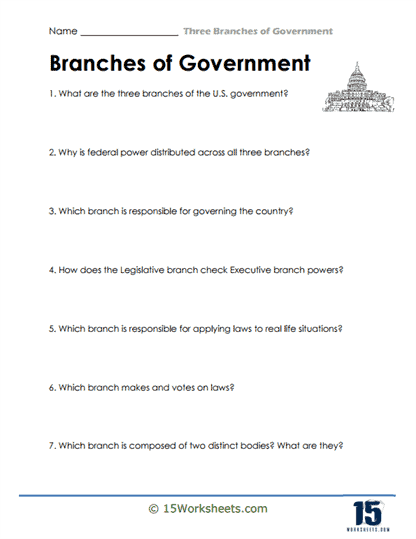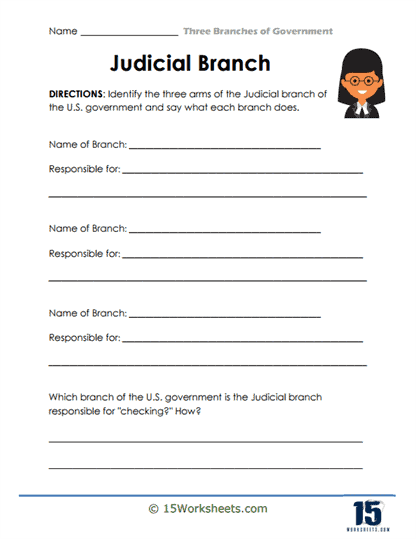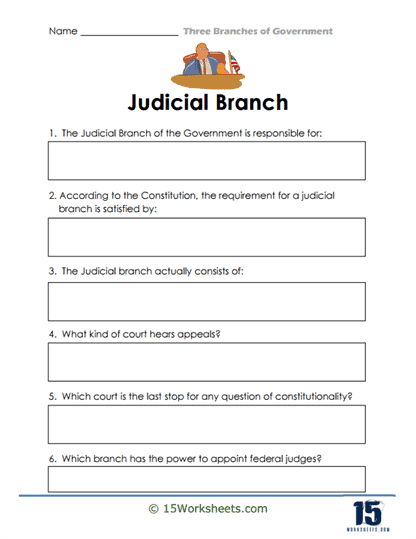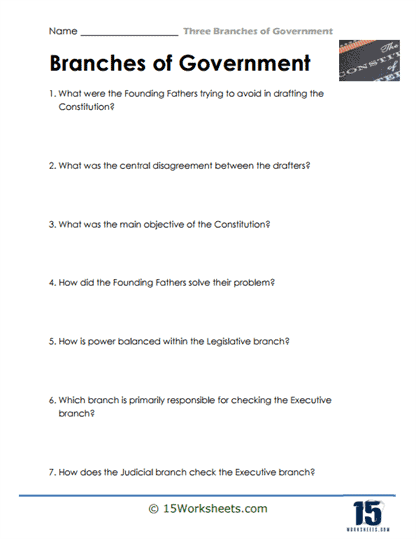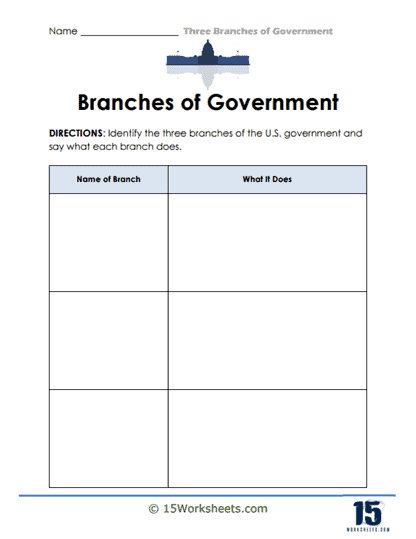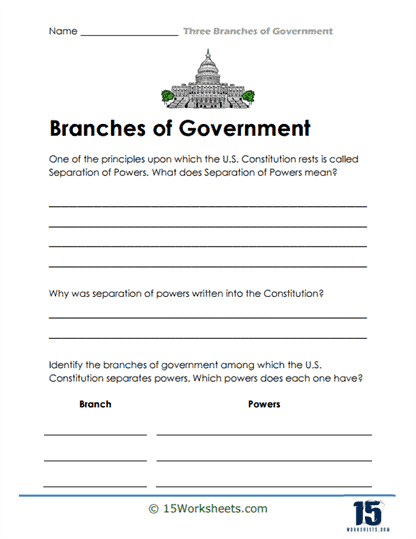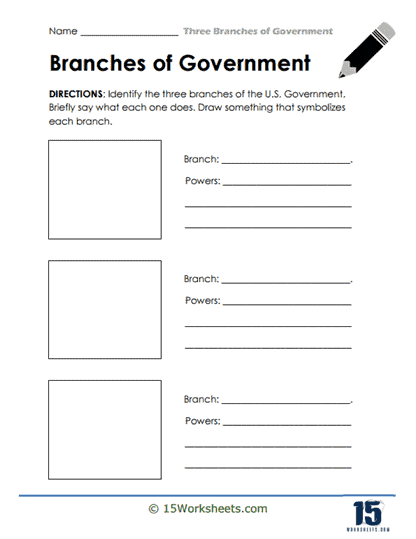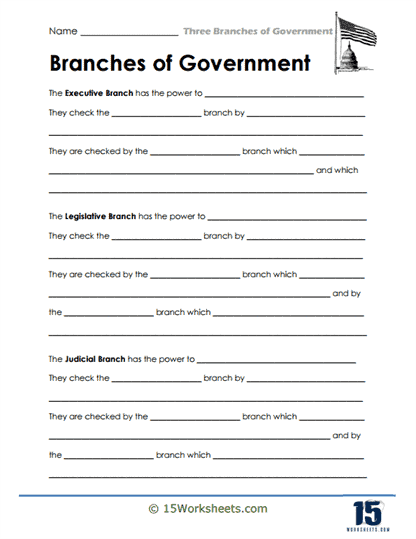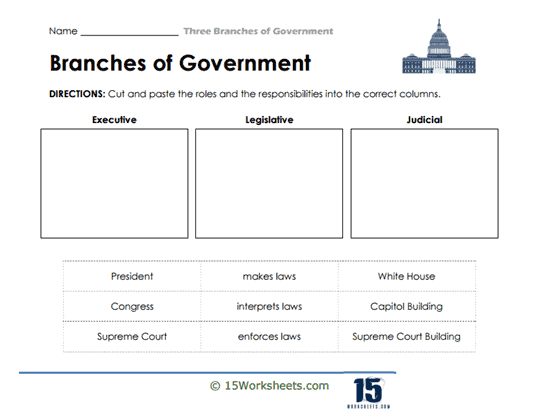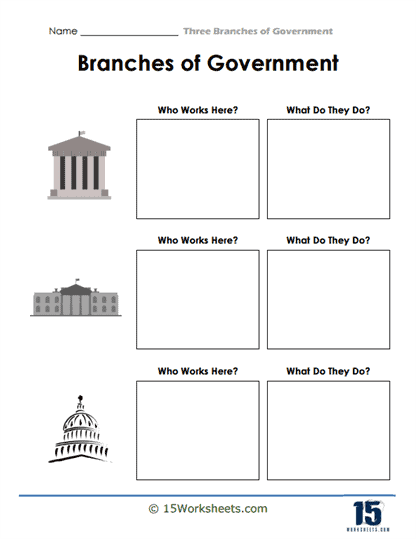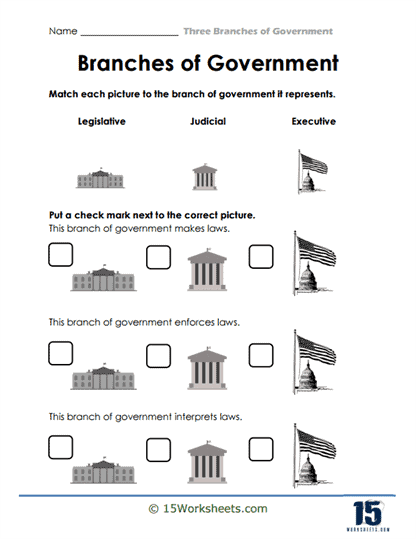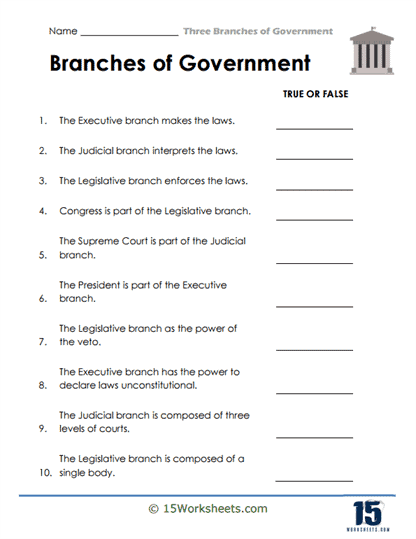Branches of Government Worksheets
About These 15 Worksheets
These worksheets were meticulously designed to offer students a comprehensive understanding of the three core divisions of the U.S. federal government: the Legislative, Executive, and Judicial branches. They serve as an educational tool that goes beyond surface-level memorization, engaging students in the distinct responsibilities, powers, and limitations that each branch holds. Through these exercises, students gain valuable insights into the mechanisms of governance, learning not only how these branches operate independently but also how they are interconnected through a system of checks and balances. This system, while structured to promote cooperation, also allows for conflict and tension, reflecting the complex nature of governing a diverse and dynamic nation. The worksheets aim to highlight this reality, encouraging students to explore how collaboration and disagreement are equally essential to the democratic process.
At the heart of the United States’ democratic framework is the principle of checks and balances, a concept that ensures no single branch or individual can dominate the federal government. This principle, which was carefully embedded in the U.S. Constitution by the Founding Fathers, creates a balance of power by assigning distinct roles and authorities to the Legislative, Executive, and Judicial branches. The Legislative branch, made up of Congress, holds the power to create laws. The Executive branch, led by the President, enforces those laws. Meanwhile, the Judicial branch, headed by the Supreme Court, interprets the laws and determines their constitutionality. However, these divisions of power are not meant to exist in isolation. They are interdependent, with each branch possessing the authority to limit or “check” the power of the others, ensuring that no single entity becomes too powerful. The worksheets guide students through this complex interaction, encouraging them to see government as a living system, where balance is maintained through both cooperation and friction.
For students to truly grasp the functioning of their government, it is critical they understand not just the individual roles of each branch, but also how they collectively work to govern the country. The worksheets are designed to foster this understanding by illustrating how the branches interact in real-world scenarios. For instance, students can explore how Congress might pass a law, but the President has the power to veto it, or how the Supreme Court can declare a law unconstitutional, nullifying the actions of both Congress and the President. These examples are crucial in demonstrating that the U.S. government is not static; it is constantly evolving as laws are created, enforced, and reviewed in the context of the nation’s needs and values. This fluid dynamic invites students to think critically about the balance of power, the importance of compromise, and the ways in which the system is designed to prevent abuses of authority.
This series of worksheets encourage students to reflect on the relevance of the branches of government in their everyday lives. While the inner workings of government can often feel distant or abstract, decisions made within these three branches profoundly affect every citizen. From laws that govern public education to decisions about healthcare and environmental policies, the actions of each branch directly impact the well-being and rights of individuals. By understanding how these branches function and interact, students can better appreciate their role as informed citizens. These educational tools not only aim to impart knowledge but also inspire civic engagement by showing students that their understanding of government equips them to participate in and influence the democratic process.
They are designed to empower students with a deeper understanding of democracy and governance. By studying the checks and balances system, students come to realize that while the U.S. government is powerful, it is also intentionally limited in scope. This limitation is a safeguard of democracy, ensuring that the government serves the people and not the other way around. The goal is for students to leave with a clear sense of how government operates, how power is distributed, and how this structure supports the preservation of individual freedoms and rights. In doing so, these worksheets provide the foundation for a lifelong engagement with democratic principles and civic responsibility.
Types of Exercises On The Worksheets
Branch Identification – At the most basic level, students might be presented with descriptions or functions and asked to identify to which branch it corresponds. Visual aids can be invaluable. Students might fill in flowcharts that show the balance of powers or delineate the process of how a bill becomes law. An exercise might list powers like “vetoing legislation,” “appointing Supreme Court justices,” or “ratifying treaties,” requiring students to match them to the correct branch.
Scenario Analysis – Worksheets might describe hypothetical (or real) situations and ask students to identify which branch would be involved, how, and why.
True/False and Multiple Choice Questions – These assess foundational knowledge about the composition, powers, and checks and balances inherent to each branch.
Essay Prompts – Delving deeper, students might be asked to discuss the significance of the separation of powers, provide an analysis of times when inter-branch cooperation or conflict was evident, or explore the implications of specific landmark Supreme Court decisions.
Case Studies – Taking real-life cases, such as executive orders, landmark legislation, or significant court decisions, students can analyze the roles played by each branch and the broader implications for American governance.
Role-playing and Simulations – Students might simulate congressional sessions, mock trials, or presidential decision-making processes to gain a hands-on understanding of each branch’s functions.
Comparative Analysis – This could involve comparing the U.S. system to other countries’ governance structures or examining how state governments mirror (or differ from) the federal model.
Discussion and Debate – Guided topics might encourage students to debate on topics like the expansion of executive powers, the lifetime appointment of justices, or the influence of lobbying on legislation.
What Are The Branches of U.S. Government?
The United States government is built on a carefully crafted framework known as the separation of powers. Rooted in the U.S. Constitution, this design divides the federal government into three distinct branches: the Legislative, Executive, and Judicial. Each branch has its own unique functions, responsibilities, and powers. However, they do not exist in isolation. Through a system of checks and balances, each branch has the authority to influence and limit the powers of the others, ensuring that no single part of the government becomes too dominant. This structure reflects the Founders’ desire to protect liberty and prevent tyranny by dispersing power and requiring cooperation across institutions.
The Legislative Branch is responsible for making the laws that govern the nation. It is established under Article I of the Constitution and is composed of a bicameral Congress, consisting of the Senate and the House of Representatives. The Senate represents the states equally, with two senators from each state, serving six-year terms. In contrast, the House is based on population, with larger states having more representatives; members serve two-year terms. Together, these two chambers deliberate, draft, and pass legislation. Beyond lawmaking, Congress holds significant powers: it controls federal spending, can declare war, and has the authority to oversee the other branches through hearings and investigations. The Senate holds additional responsibilities, such as ratifying treaties and confirming presidential appointments. The House, meanwhile, has the sole authority to initiate revenue bills and bring impeachment charges.
The Executive Branch, defined in Article II, is charged with enforcing and administering the laws passed by Congress. At its helm is the President of the United States, who serves as both the head of state and the commander-in-chief of the armed forces. The president is elected to a four-year term and may serve a maximum of two terms. As chief executive, the president has the power to sign or veto legislation, issue executive orders, negotiate treaties, and appoint federal officials, including judges and cabinet members, with Senate approval. The Vice President, who also plays a role in the legislative process by presiding over the Senate, stands ready to assume the presidency if necessary. Supporting the president is a sprawling network of federal agencies and departments-such as the Department of Defense, the Environmental Protection Agency, and the Department of Education-that carry out the day-to-day work of governance and policy implementation.
The Judicial Branch, established by Article III, serves as the interpreter of the law. It ensures that laws are applied fairly and remain in harmony with the Constitution. At the top of this branch is the U.S. Supreme Court, the highest court in the land, composed of nine justices who serve lifetime appointments. These justices are nominated by the president and confirmed by the Senate. The Supreme Court has the ultimate authority in interpreting constitutional questions, and through the power of judicial review, it can strike down laws or executive actions that are deemed unconstitutional. Beneath the Supreme Court is a system of lower federal courts, including Courts of Appeals and District Courts, which handle a vast array of federal cases, from civil disputes to criminal prosecutions.
The brilliance of the American system lies in its system of checks and balances. Each branch not only functions independently but also possesses tools to check the powers of the others. For example, Congress can override a presidential veto, confirm or reject judicial appointments, and impeach members of the executive or judiciary. The president can veto legislation and issue pardons. The judiciary, in turn, can rule acts of Congress or executive actions unconstitutional. This dynamic system encourages accountability, dialogue, and compromise among the branches and is essential for the preservation of democratic governance.
In essence, the three branches of the U.S. government form a carefully balanced structure that reflects a deep understanding of human nature and political power. The Founders, influenced by Enlightenment thinkers such as Montesquieu, believed that dividing government power among separate institutions would prevent despotism and safeguard liberty. This system, while sometimes slow or contentious, is designed to foster stability, protect individual rights, and ensure that the government remains responsive to the people it serves.
Branches of U.S. Government At A Glance
| Branch | Main Role | Headed By | Powers Include |
| Legislative | Makes laws | Congress (Senate + House) | Passing laws, declaring war, approving budgets, impeachments |
| Executive | Enforces laws | President | Vetoing laws, foreign policy, military command, appointing officials |
| Judicial | Interprets laws | Supreme Court | Judicial review, resolving constitutional disputes, interpreting federal law |

